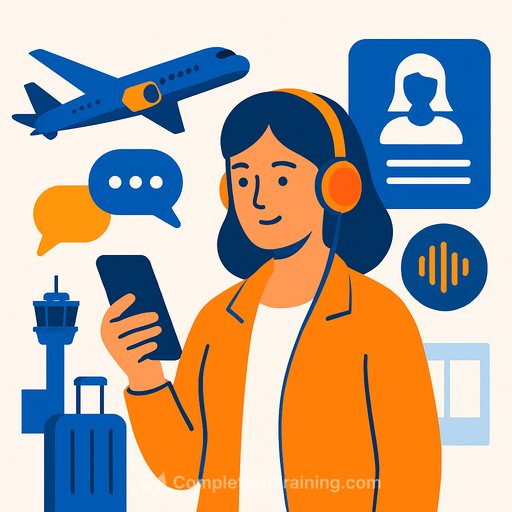How Airlines Are Personalising Passenger Communication in 2025
Last updated: 24 September 2025 22:22 * 6 min read
Airlines aren't sending more messages in 2025. They're sending smarter ones. For customer support teams, that means fewer surprises, faster resolutions, and conversations that feel relevant to each passenger's situation.
The playbook is simple: use data with consent, automate the routine, surface context for agents, and notify passengers before issues hit. Here's how leading teams are doing it-and how you can put it to work.
Summary
- Five practical moves driving personalisation: predictive AI, text-to-voice accessibility, real-time contextual messaging, multilingual support, and automated self-serve with mobile integration.
- What's next: on-device AI, richer airport experiences with 5G, live translation, and biometric opt-ins that speed the path through the airport.
- The bottom line: fewer inbound contacts, higher CSAT, better recovery during disruptions.
5 Ways Airlines Are Personalising Passenger Communication
1) Predictive, AI-Driven Service (Rebooking and Proactive Care)
AI systems read past trips, live operations, and inventory to predict issues like delays, missed connections, or gate changes. Passengers get clear options early-rebook, voucher, or standby-before they even ask. Some carriers now run generative-AI rebooking assistants with real-time alerts, paired with biometric opt-ins to move faster through checkpoints.
- What to implement: disruption triggers, auto-offers for rebooking, and one-tap confirmations in the app or SMS.
- Agent boost: push full context into the workspace (PNR, previous offers, acceptance status) so handoffs are seamless.
- Metrics: contact deflection rate, rebooking time, acceptance rate of first offer, CSAT after disruption.
IATA's One ID outlines how biometrics can streamline identity checks with proper consent and privacy controls.
2) Text-to-Voice for Accessibility
Written updates convert to natural speech across apps, IVR, kiosks, and in-flight systems. Voices can match brand tone and speak multiple languages, improving access for passengers with visual impairments or reading difficulties.
- What to implement: consistent voice packs, message templates for disruptions and boarding, and passenger opt-ins.
- Agent boost: quick-send audio snippets for critical updates to reduce back-and-forth.
- Metrics: accessibility opt-ins, IVR containment, repeat-contact rate for the same issue.
3) Real-Time, Contextual Messaging
Personalisation isn't a first name in a template. It's the right nudge at the right moment, based on live status, weather, aircraft swaps, or airport queues. If a storm hits, passengers get the reason, the plan, and choices-before frustration builds.
- What to implement: a central decision engine that listens to ops data and orchestrates messages across email, push, SMS, and WhatsApp.
- Agent boost: surface "what the passenger has already been told" to prevent mixed messages.
- Metrics: notification open/act rates, opt-out rate, NPS/CSAT during IRROPs.
4) Multilingual Assistance for Global Passengers
AI systems now converse across languages in real time. Automated chat, live agents, and in-flight announcements can deliver the same clarity to non-native speakers-without delays.
- What to implement: language detection, approved glossary for aviation terms, and human review for sensitive cases.
- Agent boost: side-by-side translation in the console with quick-switch canned responses.
- Metrics: first contact resolution by language, average handle time variance by language, translation quality audits.
5) Automating Everyday Interactions + Mobile Integration
Routine tasks-check-in, seat changes, baggage rules-are handled by AI chat and self-serve flows. Mobile apps and messaging threads carry live updates on gates, boarding groups, bag status, and in-flight services, all in one place.
- What to implement: intent-level bots for top tasks, unified threads across channels, and deep links to app actions.
- Agent boost: escalate with full conversation history and a clear "what was attempted" log.
- Metrics: self-serve completion rate, abandonment rate, agent-assisted transfers, app feature adoption.
Pro Tips for Customer Support Leaders
- Set guardrails: clear consent flows, data minimisation, and easy opt-outs across channels.
- Standardise templates: short, plain language, consistent across SMS, email, push, and voice.
- Create a disruption playbook: triggers, offers, message timing, escalation paths, and post-event follow-up.
- Close the loop: ask "Was this helpful?" after every automated action and use feedback to refine decision rules.
- Measure what matters: deflection without frustration, speed to useful option, recovery CSAT, and repeat-contact reduction.
What Is The Future of Personalised Airline Communication?
Expect smarter predictions that stay privacy-first, with more processing done on device. As 5G coverage grows, airports can offer richer guidance like AR wayfinding and live translation that keeps pace with crowds and gate changes.
Biometric opt-ins will make identity checks faster, while giving passengers clear control over how data is used. Regulators are pushing for transparency and service accountability; watch dashboards like the U.S. DOT's Airline Customer Service Dashboard for evolving standards.
The Bottom Line
Personalised communication in 2025 is practical: predict issues, offer choices fast, keep language clear, and meet passengers in their channel of choice. Do that, and you'll see fewer inbound contacts, smoother peaks, and better recovery when plans change.
If your team is upskilling on AI for support workflows, explore role-based courses here: Complete AI Training - Courses by Job.
What shifts have you seen this year in passenger communications? Which play has moved your CSAT and first contact resolution the most?
Your membership also unlocks:





